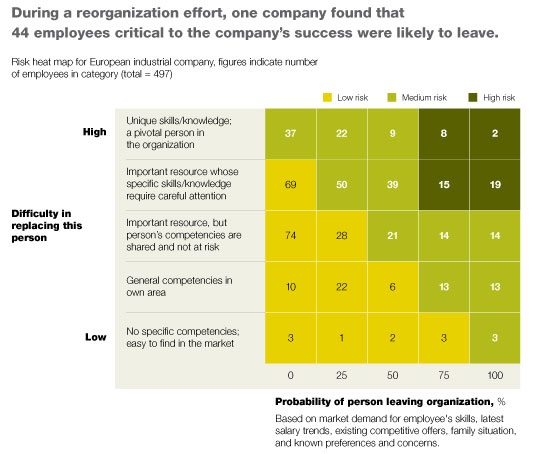Too many companies approach the retention of key employees during disruptive periods of organizational change by throwing financial incentives at senior executives, star performers, or other “rainmakers.” The money is rarely well spent. In our experience, many of the recipients would have stayed put anyway; others have concerns that money alone can’t address. Moreover, by focusing exclusively on high fliers, companies often overlook those “normal” performers who are nonetheless critical for the success of any change effort.
Our work with companies in many sectors (among them, energy, financial services, health care, pharmaceuticals, and retailing) suggests there is a better and less costly approach to employee retention—and one that will serve companies well as they merge, restructure, and reorganize to seize strategic opportunities as the economy picks up. It starts with identifying all key players, but targeting only those who are most critical and most at risk of leaving. These people are then offered a mix of financial and nonfinancial incentives tailored to their aspirations and concerns. A European industrial company applied this approach during a recent reorganization and found that it required only 25 percent of the budget that had previously been spent on a broad, cash-based scheme. What follows are three suggestions for companies with similar hopes of keeping their top talent without breaking the bank.
1. Find the “hidden gems”
HR and line managers need to work together during times of major organizational change to identify people whose retention is critical. Yet too often companies simply round up the usual suspects—high-potential employees and senior executives in roles that are critical for business success. Few look in less obvious places for more average performers whose skills or social networks may be critical—both in keeping the lights on during the change effort itself as well as in delivering against its longer-term business objectives.

These “hidden gems” might be found anywhere in the company: for example, the product-development manager in an acquired company’s R&D function who is nearing retirement age and no longer on the company’s list of “high potentials”—yet who is crucial to ensuring a healthy product pipeline; or the key financial accountant responsible for consolidating the acquired company’s next financial report. Even if the employees’ performance and career potential are unexceptional, their institutional knowledge, direct relationships, or technical expertise can make their retention critical. In one merger we recently observed, certain sales support personnel who filled orders and took inventory turned out to be just as important as the star salespeople.
Once HR and line managers have generated a thoughtful and more inclusive list of key players (usually 30 to 45 percent of all employees), they can begin to prioritize groups and individuals for targeted retention measures—in our experience, 5 to 10 percent of the workforce. The key is to view each employee through two lenses: first, the impact his or her departure would have on the business, given the focus of the change effort and his or her role in it; and second, the probability that the employee in question might leave.
When a European industrial company conducted this exercise, it mapped the outputs on a risk matrix. The results were sobering. The company had been launching a new centralized trading unit—requiring almost all traders and their support staff to relocate, with half of them heading to another country—and was steadily losing people. The risk matrix revealed that another 104 people were likely to leave. Among them were 44 employees who were critical for the success of the trading unit. To be sure, some were traders but most were IT, finance, and administrative staff with unique knowledge of the unit’s systems.
2. Mind-sets matter
One-size-fits-all retention packages are usually unsuccessful in persuading a diverse group of key employees to stay. Instead, companies should tailor retention approaches to the mind-sets and motivations of specific employees (as well as to the express nature of the changes involved).
When executives at the European industrial company looked beyond their standard retention package (bonuses plus compensation for the costs of the move) and focused instead on the needs of individual employees, they found a more nuanced situation than they had anticipated. Among the key people at risk were two main groups with two different mind-sets.1 One consisted of individuals who were worried about relocating because it would uproot their families. The people in the other, more career-driven group didn’t mind living and working abroad but wondered, as they faced change in any event, whether staying or searching for another employer would best further their careers.
In one-on-one conversations with the people in the family-oriented group, managers explored specific concerns and discussed how the company could add to the measures already in place to increase the likelihood of retaining these individuals. On the menu of incentives: an increase in base pay, assistance in finding schools and kindergartens for their children, career counseling for their spouses, language training, and alternative work arrangements so employees could work at home or commute instead of relocating.
Meanwhile, in the conversations with the career-driven people, managers offered them a cash bonus but focused primarily on the organizational chart of the new, centralized unit, which had been designed from scratch. For people who had held senior roles in their local organization, it was essential, for example, to learn about their new responsibilities and how many direct reports they would have; for many of the more junior people a key question was who their bosses would be. Also high on the agenda was a dialogue with each individual about his or her future career and leadership opportunities in the context of the unit’s new strategy.
This targeted approach, which cost just one-quarter as much as the broad financial incentives plan the company had previously applied, succeeded in stabilizing the new unit. One year after its launch, some 80 percent of the staff who received special attention had started to work in the new location—a significantly higher share than for the group that didn’t receive this attention. Since its founding, the unit has increased its sales by more than 30 percent and its earnings before interest and taxes (EBIT) by more than 90 percent.
3. Retention is about more than money
As the European industrial company’s experience suggests, financial incentives play an important role in retention—but money alone won’t do the trick. Praise from one’s manager, attention from leaders, frequent promotions, opportunities to lead projects, and chances to join fast-track management programs are often more effective than cash. Indeed, a 2009 McKinsey Quarterly survey found that executives, managers, and employees rate these five nonfinancial incentives among the six most effective motivators when the main objective of the exercise is retaining people.
One financial services firm undertaking a recent cost-cutting initiative elected to use only nonfinancial measures—including leadership-development programs—to retain the pivotal players it had identified as being at risk of departure. One year later, none of those players had quit.
Leadership opportunities are a powerful incentive in any sector. In a pharmaceuticals merger aimed at building the North American acquirer’s presence in Europe, some 50 middle managers from the acquired company accepted invitations to join trans-Atlantic teams with key roles in integrating the two organizations and developing business strategy. The chance to network with the acquirer’s senior people and develop leadership skills during the two-year program signaled to these high-potential employees—in many cases, people who had been slated for promotion before the merger was announced—that they had a promising future in the new organization. For the acquirer’s senior executives, one benefit was the opportunity to assess first hand a potential next wave of top management talent. The program was one part of a carefully designed communication and engagement plan that made it possible to sustain the energy of the 50,000-person strong workforce during the merger. The company ultimately needed to offer only 750 targeted employees a financial incentive.
When financial incentives are required, it is important to design them appropriately and use them in a targeted way. For example, one-third of the retention bonus during a merger might be paid to pivotal staff even before the deal is closed, with the remaining two-thirds to be paid out a year later—dependent in part on the recipients meeting defined performance criteria such as the successful transfer of systems from the acquired company.
Targeting retention measures at the right people using a tailored mix of financial and nonfinancial incentives is crucial for managing organizational transitions that achieve long-term business success; it’s also likely to save money.
Still, executives mustn’t view employee retention as a one-off exercise where it’s sufficient to get the incentives packages right. Rather, best-practice approaches build on continuous attention and timely communication every step of the way to help employees make sense of the uncertainty inherent in organizational change. Ultimately, what many employees want most of all is clarity about their future with the company. Creating that clarity requires significant hands-on effort from managers, including the ongoing work of tracking progress so that companies can quickly intervene when problems arise.

